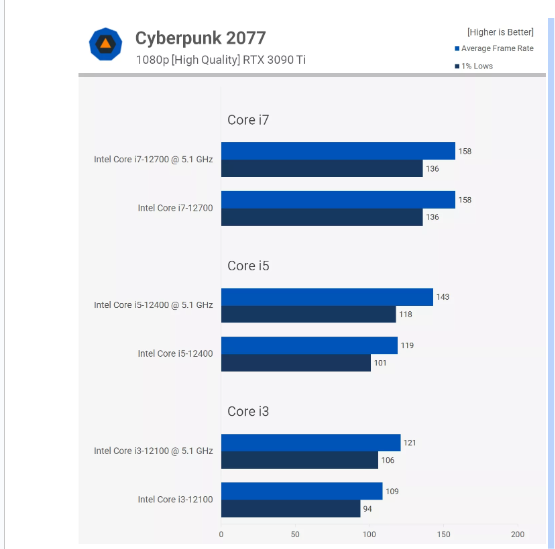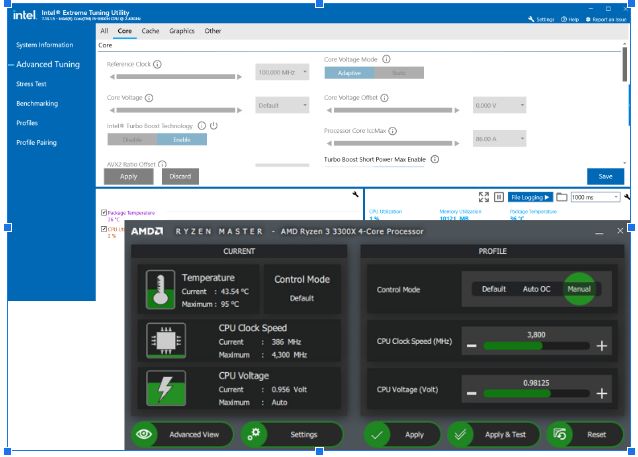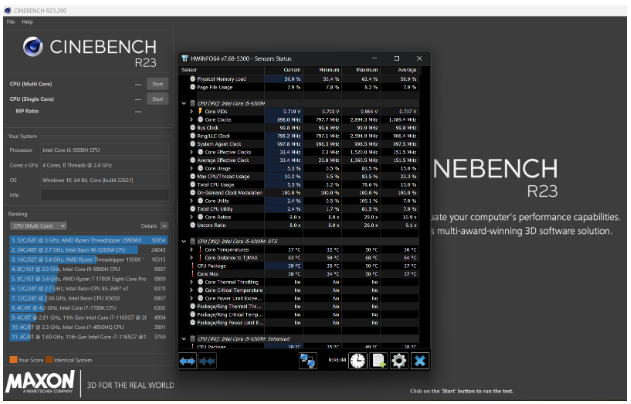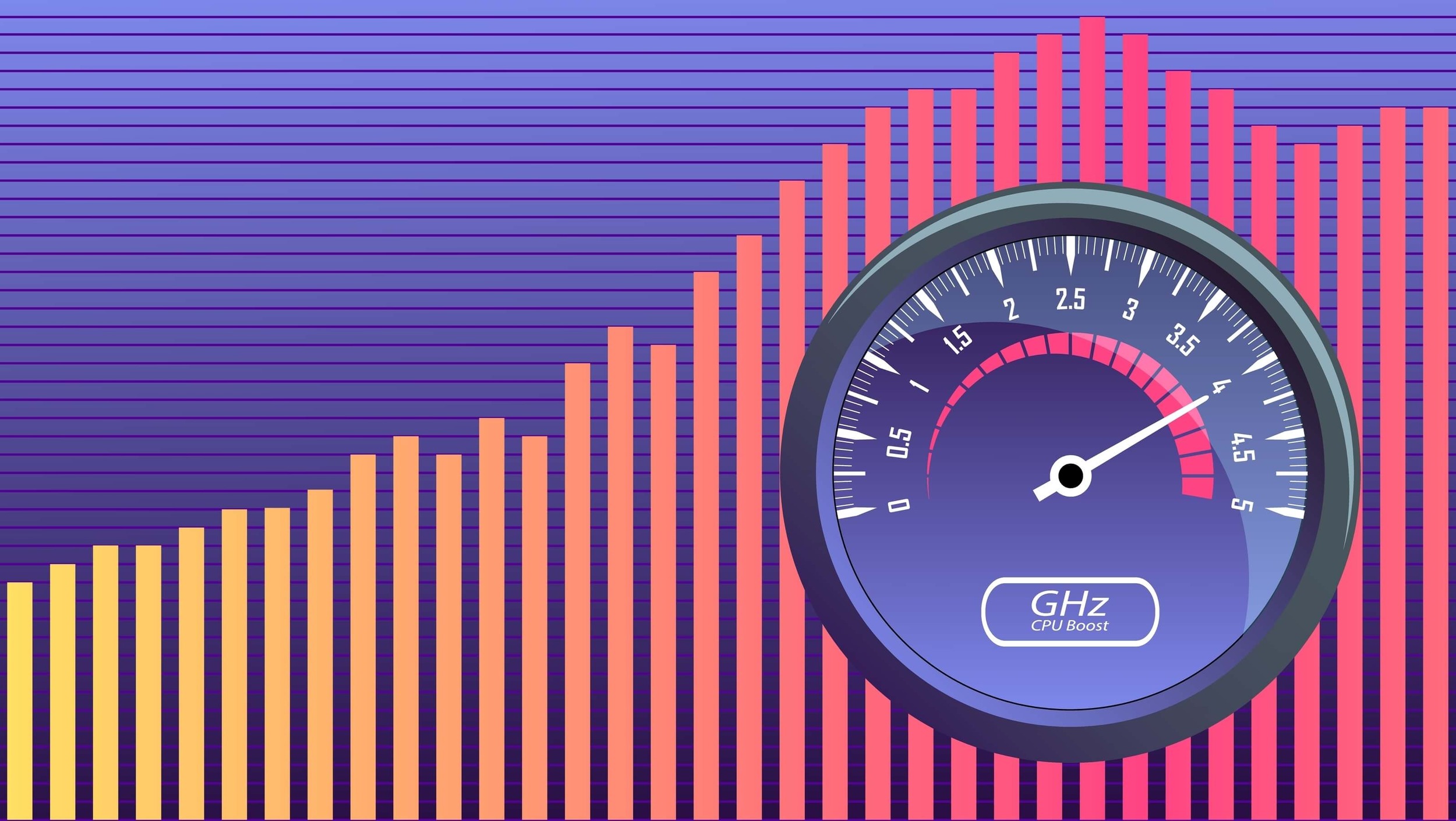In this article we’ll answer the questions “What does overclocking mean?” and “How does overclocking work?” We’ll speak of its effect on CPU performance, heat generation, and power consumption. Finally, we’ll explore the benefits and risks of increasing CPU speed, providing a comprehensive breakdown.
Let’s start.
What Is Overclocking on a PC
Overclocking involves tweaking your CPU settings to run at higher clock speed than the manufacturer’s specifications. It can significantly improve your CPU performance, but is it worth the gamble? And is accelerating your CPU clock rate safe? That’s why we’re here – to find this out.
This process entails adjusting settings in the computer’s BIOS or utilizing specialized software to exceed the CPU’s designed limits.
While it has the potential to enhance performance, it also carries risks such as instability, hardware damage, warranty voidance, and increased heat generation.
First, let’s dive into the details and clear up what clock speed is.
Understanding clock speed
If a CPU is the brain, then clock speed is its electrical impulses, dictating the pace of operations.
Why is clock speed so vital? Imagine it as the engine RPM in a car; a higher clock speed means the CPU can process more instructions in a given timeframe. This translates to quicker data processing, enabling your computer to handle tasks more swiftly.
A higher clock speed often correlates with better performance in demanding applications and tasks, such as gaming, video editing, and mining.
Reasons for overclocking
Pushing CPU beyond specs, while not without risks, can be tempting for those seeking to boost performance on their computers. Here are several reasons behind the decision to overclock a CPU:
- Performance improvement: Overclocking increases the clock speed, allowing the CPU to process instructions at a faster rate. This can lead to improved performance, especially during resource-intensive tasks.
- Gaming advantages: Gamers often overclock their CPUs to achieve higher frame rates and smoother gameplay. This can be crucial in competitive gaming, where every fraction of a second can make a difference.
Do you know which are the most demanding PC games of 2024?
However, as the graph below shows that the FPS difference between a 5.1 GHz overclocked Intel CPU and a stock one in Cyberpunk 2077 is not a game changer.

- Multitasking efficiency: It can benefit users who frequently engage in multitasking. It helps the system respond more efficiently while running simultaneous programs.
- Cost-effectiveness: It provides a way to extract additional performance from existing hardware without the need for a costly upgrade.
- Addressing a CPU bottleneck: CPU bottlenecks can occur when your CPU can’t keep up with other system components, limiting overall performance. Overclocking may be a solution to this issue, increasing your CPU capabilities to match other components’ performance.
- Revitalizing older systems: For users with older systems, adjustment of clock speed can breathe a new life into aging hardware, extending its usability and delaying the need for a complete system upgrade.
How Does Overclocking Work
As mentioned before, overclocking is the art of pushing your CPU beyond its factory-set clock speed to improve performance. But what does it mean exactly?
Base clock and multiplier
BCLK serves as the fundamental frequency of your motherboard’s chipset. This central hub facilitates communication and coordination among essential components like the CPU, GPU, RAM, storage, and hardware ports.
The default value of BCLK is typically 100 MHz, meaning the chipset can execute 100 million calculations per second. Sounds huge, but with modern CPUs running at speeds like 4.5 GHz (4.5 billion operations per second) and world record numbers exceeding 8 GHz, adjusting BCLK alone is insufficient to match these high levels.
To synchronize the comparatively modest BCLK with the blazing speeds of modern CPUs, the multiplier, also known as the CPU core ratio, comes into play. The multiplier acts as a scaling factor, allowing the CPU to perform more operations per BCLK cycle. Generally speaking, CPU clock speed is determined by multiplying BCLK with the CPU core ratio.
Given the multiplier’s substantial range (usually between 30 and 45), even slight BCLK adjustments can noticeably increase CPU clock speed.
Be extra cautious, as the CPU chipset is connected with various motherboard components, such as PCIe lanes and SATA ports, which means that tweaking the base clock by more than two or three percent may result in system instability, data corruption, or even data loss.
CPU Strap
Some CPUs support a higher band frequency (125 MHz), which is called a CPU strap. It allows for a finer level of control, as it’s directly connected with your RAM, meaning that if your memory can handle higher speeds, you can improve your system performance even more.
While CPU straps provide additional flexibility, it’s essential to strike a balance. Straying too far from default values can potentially trigger system issues. Thorough testing and monitoring are crucial to ensure that adjustments don’t compromise system stability.
FSB, DMI, QPI
In the context of overclocking, we can’t omit such components as the Front Side Bus (FSB), Direct Media Interface (DMI) and QuickPath Interconnect (QPI).
The FSB is a communication pathway that links the CPU to other components on the motherboard, including memory and input/output devices.
In the past, when FSB played a more significant role, overclockers would manipulate the FSB frequency to increase the overall clock speed of the CPU. However, modern CPUs, especially those from Intel, have turned to more advanced technologies.
The DMI is a high-speed interface used in Intel architectures to connect the CPU to the chipset and other components on the motherboard. It replaced the FSB in newer Intel platforms.
While the DMI itself is not directly manipulated during the overclocking process, adjusting the CPU voltage, multiplier and base clock also affects the DMI’s speed and, subsequently, the communication between the CPU and other components.
The QPI is another Intel technology designed to replace the FSB. It serves as a high-speed point-to-point interconnect between processors and other components, providing improved bandwidth and efficiency compared to the FSB.
Some enthusiasts suppose that manually changing the QPI bandwidth can benefit in higher performance, however, there’s no solid evidence of that. The default QPI values are more than enough, especially considering that they would automatically adjust during CPU overclocking.
All in all, while the FSB, DMI, and QPI are not the primary focus of overclocking adjustments, their roles in connecting the CPU and other components make them relevant. That’s why it is important to understand the impact on the system when increasing CPU speed to maintain stability.
Vcore
The last, but not least, is Vcore or the core voltage. It is the electrical potential applied to the CPU’s processor core. It determines the amount of power supplied to the CPU to ensure stable operation and is measured in volts (V).
Increasing the CPU’s clock speed often requires additional power. Adjusting the core voltage allows overclockers to provide the necessary electrical potential to sustain the higher clock speeds.
It’s important to understand that a higher core voltage increases heat production. When adjusting clock speed, one must carefully manage temperature levels to prevent overheating, as excessive heat can degrade CPU performance and even lead to hardware damage. In this situation, effective cooling solutions are crucial.
Summary
Overclocking is a process of altering the base clock, multiplier, and voltage values to achieve better performance during gaming and other resource-intensive tasks.
Accelerating CPU clock rate, including adjustments of the Vcore, BCLK and other adjustable parameters, is typically done through the computer’s BIOS or UEFI interface or with the help of specialized software, like Intel XTU or AMD Ryzen Master.

After each change in the settings, thorough stress testing is necessary to ensure system stability. It’s also vital to have temperature and performance monitoring tools at hand to prevent overheating. A tool like Cinebench will subject your CPU to demanding workloads, while a monitoring tool like HWiNFO will help you keep track of the most important figures.

In essence, overclocking is a search for a delicate balance of clock speeds, voltages, and temperature to unleash additional performance from your CPU, but it also can lead to system instability, reduced component lifespan, and voided warranties.
Before boosting your CPU performance, it’s essential to thoroughly research your specific CPU and motherboard and understand the associated risks. Let’s uncover what those risks are.
Risks of Overclocking
While overclocking promises appealing prospects of improved performance, it comes with a variety of risks that users must weigh carefully:
- Voiding warranties
First of all, as accelerating CPU clock rate often involves pushing hardware beyond manufacturer specifications, it may void CPU and other components warranties, leaving you deprived of manufacturer support in case of hardware failures.
- Overheating
Overclocked CPUs generate more heat, potentially pushing temperatures beyond safe thresholds. This can lead to thermal throttling, reducing the clock speed to dissipate heat, and even cause permanent damage to the CPU or other components in extreme cases. As a matter of fact, there have been several confirmed incidents of AMD CPUs burning out due to increased voltages.
- Reduced CPU lifespan
Increased voltages and temperatures can lead to accelerated wear and tear. This can result in a shorter lifespan for crucial hardware components, such as the CPU or GPU.
- System instability
Aggressive overclocking attempts can result in stutters, crashes, blue screens, or unexpected shutdowns.
- Data corruption and loss
Enhancing processor speed can lead to consequences beyond system crashes. In some cases, overclocking may lead to data corruption or even data loss.
- Compatibility issues
Pushing CPU beyond specs may result in compatibility issues with certain applications, drivers, or peripherals. This can lead to unpredictable behavior and complicate the overall usability of the system.
- Increased power consumption
Boosting CPU performance generally requires higher voltages, increasing power consumption. This can lead to higher electricity bills and may require a more robust power supply unit to support the additional power requirements.
- No one-size-fits-all solution
Each system is unique, and what works for one setup may not apply universally. Copying overclocking settings from others without a deep understanding of the specific hardware and cooling solutions can lead to unintended consequences.
Conclusion
We’ve covered all major aspects of overclocking and explained how it works in detail. We’ve outlined the benefits of this method and highlighted the risks.
Increasing CPU speed is a risky and dangerous solution that, with all of its appeal, doesn’t necessarily bring along the positive outcome and should only be performed upon understanding and accepting potential consequences, such as warranty void, overheating, and other unpleasantries.
However, if you’ve made up your mind to go with it, make sure to follow our guide that will facilitate the process, making this path a little bit less rocky.



